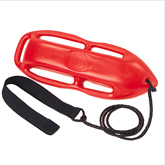Lifeguard Rescue Tubes are required rescue equipment for swimming pools and waterparks. Read on to learn about the rescue tubes, their inventor, and the history of their development.
What Is A Rescue Tube?

A rescue tube is floating buoy that facilitates lifeguard water rescues, allowing rescuers wrap the rescue tube around victims. A
buoy or rescue tube is a piece of lifesaving equipment used in water rescue. The buoyancy of the rescue tube helps support the weight of both the victim and rescuer, providing reassurance to distressed swimmer.
A harness with strap allows lifeguard to secure the strap to their own body. Some rescue tubes use a clip to enclose the bent tube around the victim, so it will not open up and release the victim into the water.
Rescue Tube History
Pete Peterson- Inventor Of The Rescue Tube
In 1932, 19 year old Preston "Pete" Peterson was both a championship surfer and a member of the inaugural staff of Santa Monica, California lifeguards.
Peterson was also an innovating craftsman, producing high-performance surfboards and paddleboards made from balsa and redwood.
Pete's entrepreneurial ability didn't end there. In 193,5 he invented a yellow, inflatable rescue buoy equipped with a snap hook and harness, known as the Peterson Belt, that inspired the modern day rescue tubes used by today's lifeguards.
Rescue Cans Vs. Rescue Tubes
Although truly revolutionary, the Peterson Belt criticized by some rescuers for its fragility, as it periodically deflated during rescues.
Some lifeguards preferred the intrepid Rescue Can, a floating buoy made from a aluminum or steel.
Rescue Cans likely caused a trivial injuries to the rescued, but their sturdy construction resisted puncturing.
Both sides of the Rescue Can Vs. Rescue Tube argument still exist today; the debate still persists in Lifeguarding blogs and communities.
1964 The Rescue Tube Rebounds
In 1964, the problem of the deflating rescue tube was solved. The redesigned rescue tube used a single piece of highly buoyant foam rubber that was dipped into a coating of liquid rubber. The result was soft, flexible rescue device that wouldn't hurt swimmers in peril.
Modern Rescue Tube Construction
Rescue Tube Body
Bodies: Rescue tube bodies are at least 40 inches in length and are constructed from soft, vinyl-coated PVC foam. Rounded edges are ideal, creating a naturally hydrodynamic design to reduce drag as it travels through in the water. This streamlined design is also ideal for increasing the life of the vinyl coating; soft, vinyl coatings applied to rounded edges are crack-resistant by design.
Clips: Clips for fastening rescue tubes around the victim are made from a sturdy, lightweight Delrin buckles to make swimmers more comfortable and reduce the incidence of swimmer injury during rescue.
Thickness: Added thickness boosts buoyancy, making victim retrieval easier for lifeguards.
Rescue Tube Harness & Towline
Polypropylene rope is strung through the entire tube body, extending tube life by protecting the tube strap from pulling out.
A Nylon shoulder harness loops under one arm and over the opposite shoulder, allowing lifeguards to tow victims safely to shore without compromising their swim stroke. The extra wide harness dissipates force placed on the lifeguard's shoulder, making the rescue as focused and straightforward as possible.
Interested in becoming a lifeguard?
Go for it- the world needs more heroes. Check out our other lifeguarding articles about rescue cans.
See you at the pool,
Robin

 A rescue tube is floating buoy that facilitates lifeguard water rescues, allowing rescuers wrap the rescue tube around victims. A buoy or rescue tube is a piece of lifesaving equipment used in water rescue. The buoyancy of the rescue tube helps support the weight of both the victim and rescuer, providing reassurance to distressed swimmer.
A harness with strap allows lifeguard to secure the strap to their own body. Some rescue tubes use a clip to enclose the bent tube around the victim, so it will not open up and release the victim into the water.
A rescue tube is floating buoy that facilitates lifeguard water rescues, allowing rescuers wrap the rescue tube around victims. A buoy or rescue tube is a piece of lifesaving equipment used in water rescue. The buoyancy of the rescue tube helps support the weight of both the victim and rescuer, providing reassurance to distressed swimmer.
A harness with strap allows lifeguard to secure the strap to their own body. Some rescue tubes use a clip to enclose the bent tube around the victim, so it will not open up and release the victim into the water.
 A rescue tube is floating buoy that facilitates lifeguard water rescues, allowing rescuers wrap the rescue tube around victims. A buoy or rescue tube is a piece of lifesaving equipment used in water rescue. The buoyancy of the rescue tube helps support the weight of both the victim and rescuer, providing reassurance to distressed swimmer.
A harness with strap allows lifeguard to secure the strap to their own body. Some rescue tubes use a clip to enclose the bent tube around the victim, so it will not open up and release the victim into the water.
A rescue tube is floating buoy that facilitates lifeguard water rescues, allowing rescuers wrap the rescue tube around victims. A buoy or rescue tube is a piece of lifesaving equipment used in water rescue. The buoyancy of the rescue tube helps support the weight of both the victim and rescuer, providing reassurance to distressed swimmer.
A harness with strap allows lifeguard to secure the strap to their own body. Some rescue tubes use a clip to enclose the bent tube around the victim, so it will not open up and release the victim into the water.










Leave a Comment
Your email address will not be published. Required fields are marked *